The Divine Origins of Sohrai Khovar Painting
Legend holds that Sohrai art originated as an offering to nature gods and goddesses to bless the land with a bountiful harvest. In Santhali folklore, it is believed that Jaher Ayo (goddess of the forest) and Marang Buru (god of the mountains) would descend to Earth during the harvest festival to bless their devotees. The Sohrai paintings created during this time symbolize fertility, protection, and ancestral connection.
One of the most revered styles is Sohrai Khovar painting, which is traditionally created by women on the walls of homes. The term "Khovar" refers to the bridal chamber, as these paintings were historically used to decorate the rooms of newlyweds, symbolizing prosperity and marital bliss.
Themes and Symbolism in Sohrai Art
Sohrai paintings feature a rich variety of themes, often inspired by tribal life, nature, and mythology. Some of the most common elements include:
🦚 Sohrai Art Bird Motifs – Birds like peacocks and sparrows are often depicted, representing harmony and beauty.
🐘 Wildlife Depictions – Animals such as elephants, bulls, and snakes symbolize strength, protection, and fertility.
🌳 Sohrai Tree and Nature Themes – Trees represent life, growth, and connection to ancestral spirits.
🐠 Sohrai Art Fish Designs – Fish are considered a symbol of abundance and prosperity in many tribal cultures.
The paintings are distinguished by their bold lines, rhythmic patterns, and the symbolic use of colors:
🔴 Red – Represents the blood of ancestors, fertility, and life force.
⚫ Black – Symbolizes eternity, ancestral spirits, and divine protection.
⚪ White – Created using rice paste, signifying purity and nourishment.
Sohrai Art Technique and Materials
Sohrai Painting Materials and Process
Sohrai paintings are traditionally made using natural earth-based colors. The process includes:
✔️ Base Layer – Walls are coated with white mud, creating a smooth canvas.
✔️ Painting Tools – Artists use their fingertips, chewed twigs, or broken combs to carve intricate patterns.
✔️ Natural Colors – Earth-based pigments such as:
-
Kali Mitti (black mud) – For outlines and detailing
-
Laal Mitti (red mud) – For vibrant designs
-
Pili Mitti (yellow ochre) – For warm accents
The spontaneous freehand technique of Sohrai art drawing reflects the artists' deep intuitive creativity, passed down from generation to generation.
Sohrai Art in Modern Spaces
Sohrai Art as Home Décor
Can Sohrai wall paintings be integrated into contemporary home interiors? Absolutely! Today, artists and designers are bringing Sohrai art images into modern décor through:
🏡 Murals & Wall Hangings – Large-scale Sohrai wall paintings add a rustic charm to contemporary homes.
🎨 Canvas & Fabric Art – Many artists create sohrai painting images on paper, cloth, and handmade canvas, making them portable and easy to display.
📦 Handcrafted Home Décor – From cushions and curtains to pottery and furniture, Sohrai patterns bring tribal heritage into urban living spaces.
Whether displayed as traditional wall art or reimagined in modern interiors, Sohrai paintings remain a timeless expression of tribal craftsmanship.
Sohrai Art in Ranchi and Beyond
Revival of Sohrai Painting in Ranchi
Ranchi, the capital of Jharkhand, is playing a crucial role in the preservation and promotion of Sohrai paintings. Various initiatives are supporting local tribal artists, helping them gain national and international recognition. Art fairs, exhibitions, and online platforms are making Sohrai art images more accessible to a global audience.
If you're looking to explore or buy authentic Sohrai paintings in Ranchi, many tribal art collectives and artisan markets offer stunning handcrafted pieces.
Famous Sohrai Art Images and Artists
Sohrai artists, primarily tribal women, have mastered the art of spontaneous freehand painting, keeping the tradition alive. Their stunning compositions showcase the rich storytelling and deep-rooted symbolism of tribal life. Some of the most recognized Sohrai art images depict:
✔️ Bridal Sohrai Khovar paintings – Used in wedding ceremonies.
✔️ Sohrai festival wall art – Celebrating harvest and nature worship.
✔️ Animal and bird murals – Showcasing the deep bond between nature and humans.
These artworks are not just visually stunning but also carry deep cultural and spiritual meanings.
Easy Sohrai Painting – How to Get Started
For beginners interested in learning Sohrai painting, here are some simple steps:
✏️ Step 1: Sketch basic outlines of birds, trees, and animals.
🎨 Step 2: Use natural colors (or acrylics for a modern touch).
🖌️ Step 3: Create fine details with twigs, combs, or brushes.
🖼️ Step 4: Let it dry and add final touch-ups.
Whether you're an artist or an art enthusiast, Sohrai painting drawings are a fun and creative way to connect with India's rich tribal art forms.
FAQs About Sohrai Art
What is the history of Sohrai art?
Sohrai art history dates back centuries, rooted in tribal rituals and nature worship. It is primarily practiced by indigenous communities in Jharkhand, Bihar, and Odisha, evolving as a symbol of cultural identity and artistic expression.
What materials are used in Sohrai paintings?
Traditional Sohrai painting materials include:
🖌️ Natural earth pigments (black, red, yellow, and white mud).
🌿 Plant-based brushes (twigs, chewed wood, and cloth swabs).
🏡 Handcrafted surfaces (mud walls, clay pots, and handmade paper).
Where can I buy Sohrai paintings in Ranchi?
You can find authentic Sohrai paintings in Ranchi at:
✔️ Tribal art fairs and exhibitions.
✔️ Local artisan collectives and craft stores.
✔️ Online platforms featuring tribal artists.
Is Sohrai art difficult to learn?
No! Easy Sohrai painting tutorials are available online, making it accessible for anyone to try. Whether for home décor or art workshops, Sohrai art drawing is an enjoyable and rewarding experience.
Conclusion
The Sohrai painting tradition is a living testament to India's tribal artistry, blending spiritual symbolism with artistic brilliance. Whether you're admiring its heritage, purchasing authentic Sohrai paintings, or trying your hand at an easy Sohrai painting, this unique art form offers an immersive cultural experience.
Want to explore more Sohrai art images and artworks? Browse our curated collection of traditional and modern Sohrai paintings today!
Show Less





























































